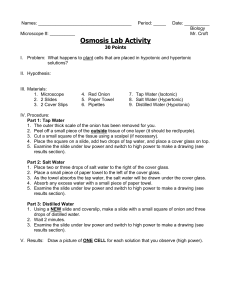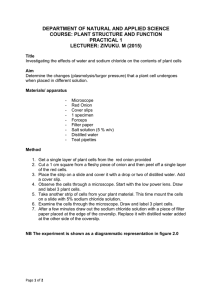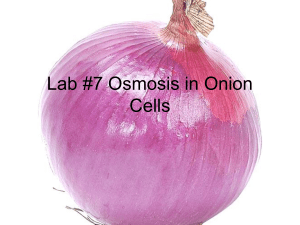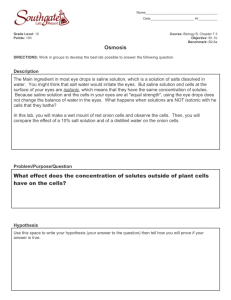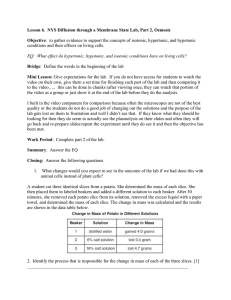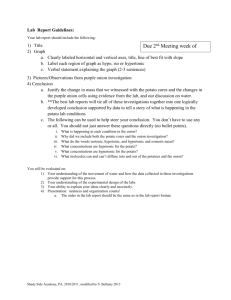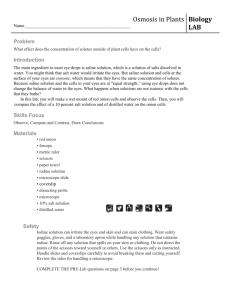Osmosis Lab_NOT digital
advertisement
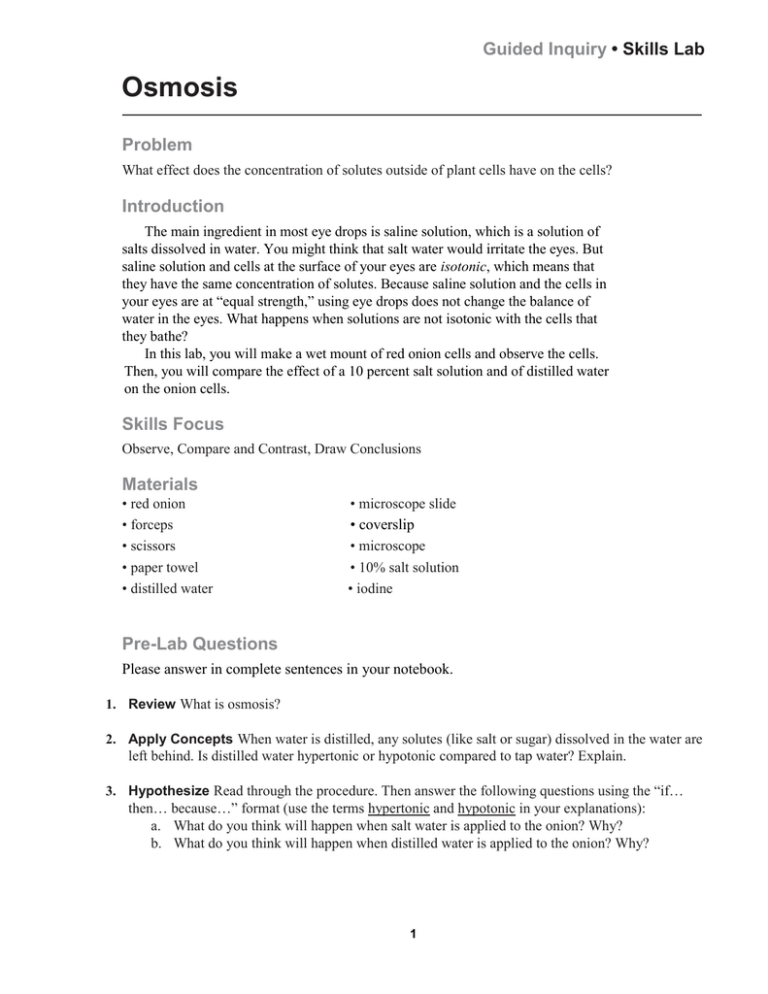
Guided Inquiry • Skills Lab Osmosis Problem What effect does the concentration of solutes outside of plant cells have on the cells? Introduction The main ingredient in most eye drops is saline solution, which is a solution of salts dissolved in water. You might think that salt water would irritate the eyes. But saline solution and cells at the surface of your eyes are isotonic, which means that they have the same concentration of solutes. Because saline solution and the cells in your eyes are at “equal strength,” using eye drops does not change the balance of water in the eyes. What happens when solutions are not isotonic with the cells that they bathe? In this lab, you will make a wet mount of red onion cells and observe the cells. Then, you will compare the effect of a 10 percent salt solution and of distilled water on the onion cells. Skills Focus Observe, Compare and Contrast, Draw Conclusions Materials • red onion • forceps • scissors • paper towel • distilled water • microscope slide • coverslip • microscope • 10% salt solution • iodine Pre-Lab Questions Please answer in complete sentences in your notebook. 1. Review What is osmosis? 2. Apply Concepts When water is distilled, any solutes (like salt or sugar) dissolved in the water are left behind. Is distilled water hypertonic or hypotonic compared to tap water? Explain. 3. Hypothesize Read through the procedure. Then answer the following questions using the “if… then… because…” format (use the terms hypertonic and hypotonic in your explanations): a. What do you think will happen when salt water is applied to the onion? Why? b. What do you think will happen when distilled water is applied to the onion? Why? 1 Procedure 1. Use your fingers to separate one of the curved layers from the onion. Bend the layer until the shiny surface cracks. Look for a thin, clear layer of tissue at the place where the surface cracked. Use forceps to peel away some of the tissue. Use a scissors to cut away the tissue, if necessary. 3. Place a drop of iodine in the center of a clean glass slide. Use the forceps to place the onion sample in the drop of iodine on the slide and to gently flatten the tissue so that no air bubbles are trapped underneath the tissue. 4. Place a coverslip at an angle so that one edge touches the drop of iodine. Slowly lower the coverslip over the onion tissue. 5. Use the low-power objective to locate some onion cells. Then, switch to medium power and focus with the fine adjustment, and finally, switch to high power. 6. Focus so you see a few cells clearly. Carefully draw a picture of 1-2 cells. Title your drawing with the type of solution used, and the power the cells are being viewed under power (ex. Onion in iodine solution under high power [400x]). Label the cell wall, nucleus, and cytoplasm. Effects of Salt 7. Put a few drops of salt solution at one edge of the coverslip. Hold a small piece of paper towel at the other end of the coverslip to draw the salt solution underneath the coverslip. 8. After 3 minutes, observe the onion cells. Use low power to view the onion cells again. Switch to medium power and then high power. 9. Focus so you see a few cells clearly. Carefully draw a picture of 1-2 cells. Title your drawing with the type of solution used, and the power the cells are being viewed under. Label the cell wall, nucleus, plasma membrane, and cytoplasm. After Adding Salt Solution 10. Put a few drops of distilled water at one edge of the coverslip. Hold a new piece of paper towel at the other end of the coverslip to draw the distilled water underneath the coverslip. 11. After 3 minutes, observe the onion cells again. Use low power to view the onion cells again. Switch to medium power and then high power. 12. Focus so you see a few cells clearly. Carefully draw a picture of 1-2 cells. Title your drawing with type of solution used, and the power the cells are being viewed under. Label the cell wall, nucleus, plasma membrane (if visible), and cytoplasm. Write-up 1. Create a word document. Head the document with your name, the date, and your period. 2. Title the lab, “What effect does the concentration of solutes outside of plant cells have on the cells?” 3. Title the first section, “Introduction.” Write a paragraph summarizing what you know about osmosis and how cells respond in hypertonic, hypotonic, and isotonic solutions. End this paragraph with your hypotheses (If… then… because…) that you wrote in your pre-lab. 4. Title the second section “Analysis” and answer the following questions in complete sentences: a. Compare and Contrast How were the cells different after you added the salt solution? What happened after you added the distilled water? b. Draw Conclusions What caused the changes you observed when the onion cells were surrounded by the salt solution? Was the salt solution hypertonic or hypotonic compared to the cells? c. Draw Conclusions What caused the changes you observed when the onion cells were surrounded by distilled water? Was the distilled water hypertonic or hypotonic compared to the cells? d. Infer A red blood cell can swell until it bursts. What prevented the onion cells from bursting when they swelled? 5. Attach the pictures you drew in class. Make sure each drawing has a title and the appropriate parts are labeled. Write-up 1. Create a word document. Head the document with your name, the date, and your period. 2. Title the lab, “What effect does the concentration of solutes outside of plant cells have on the cells?” 3. Title the first section, “Introduction.” Write a paragraph summarizing what you know about osmosis and how cells respond in hypertonic, hypotonic, and isotonic solutions. End this paragraph with your hypotheses (If… then… because…) that you wrote in your pre-lab. 4. Title the second section “Analysis” and answer the following questions in complete sentences: a. Compare and Contrast How were the cells different after you added the salt solution? What happened after you added the distilled water? b. Draw Conclusions What caused the changes you observed when the onion cells were surrounded by the salt solution? Was the salt solution hypertonic or hypotonic compared to the cells? c. Draw Conclusions What caused the changes you observed when the onion cells were surrounded by distilled water? Was the distilled water hypertonic or hypotonic compared to the cells? d. Infer A red blood cell can swell until it bursts. What prevented the onion cells from bursting when they swelled? 5. Attach the pictures you drew in class. Make sure each drawing has a title and the appropriate parts are labeled.

